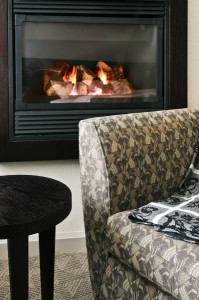All About Chimney Liners
Problems in your chimney’s flue can pose a threat to your family’s health and safety. It is important to have a fully-functional and efficient chimney liner. Here’s what you need to know:
Problems in your chimney’s flue can pose a threat to your family’s health and safety. It is important to have a fully-functional and efficient chimney liner. Here’s what you need to know:
Let’s Talk Creosote Removal
Have you noticed any black particles and burnt-like marks on your chimney walls? You might think it’s just stained because of the smoke, however these should not be underestimated, because creosote buildup can become quite dangerous.

Don’t forget to have your chimney cleaned and inspected at least once a year to maximize output and safety.
What is that black substance coating your chimney walls? It’s called creosote, a chemical byproduct of open combustion from burning either hardwood or softwood. These two types of wood usually need to be seasoned and dried up to at least six months so that only minimal production of creosote is made. This means that creosote production is inevitable and the biggest dilemma once creosote has built up in your chimney is the probability of chimney fires occurring.
So because we can’t prevent it from forming, the next best thing is to make sure that it is regularly removed. When you talk about creosote buildup, there are three levels. Thankfully our CSIA-licensed chimney sweeps here at Hudson Chimney are ready to take full control and assess, clean and remove creosote.
Level I
The first stage is usually called soot. It’s still flaky and dusty like ash only that it’s found in the chimney walls. It is the slightest form with maybe a layer or two and can easily be removed by a chimney brush. We usually just brush it off. The process takes very little time but before the removal process is done, we first inspect and do a little cleaning.
Level II
The second stage of creosote already has tar-like features. It is now harder to remove and we usually need to use stiffers or special kinds of brushes. By now, the layers are getting thicker. Removing it will take more time than usual. During this level, creosote is building up to be more flammable and more dangerous. Nonetheless, it can still be removed.
Level III
The last and final stage is the most difficult to remove and the most dangerous. It is no longer called creosote but it is now called glaze. It is thick, totally black and is like candle wax; a hard, glossy, dark mass. By now, the chance of chimney fires occurring is greater.
To prevent this, constant cleaning and removing of creosote is the ultimate key. Once creosote starts to build up, contact Hudson Chimney so that we can monitor and lessen the problem. Give us a call and we’ll tell you more!
Once burned, solid fuels like wood, coal, and pellets will leave homeowners with ashes to remove. The amount of ash and frequency of removal will depend on several factors including the type of wood burned (softwoods or hardwoods, anthracite coal or bituminous, etc.), the type of fuel, and the appliance itself. For instance, if you burn coal you’ll have much more ash than you would from burning wood. Ash will also contain different substances depending on the fuel. Coal ash contains things like cobalt and boron that are toxic to humans, animals, and plants.
Precautions must be taken both during and after ash removal, and believe it or not, there may be ways to reuse your ash once you’ve removed it. Perhaps in your garden! Read on for all the basics of ash removal or feel free to call Hudson Chimney with any questions you may have. Also refer to the Chimney Safety Institute of America’s guide called “To Remove or Not to Remove Ash.”
We would venture to say that the majority of homeowners who scoop ash do so into a simple metal pail. This pail then gets set outside. This isn’t a great idea, especially if it’s being set outside onto a wooden porch. Because hot coals can survive buried beneath ash for even a few weeks it is imperative to treat ash very carefully, as a hot pail can char a wooden deck. We’ve also seen coals be blown onto a deck, where they may catch fire.
The answer to these potential problems is to purchase a dedicated ash pail or ash holder, which should have a large handle and a bottom that’s slightly offset from the very bottom so that it doesn’t make contact with the surface on which it’s resting. Most importantly, the pail or holder should come equipped with a lid that closes tightly. There are numerous options for ash pails and holders in many styles so you don’t have to sacrifice style for safety.
And if you have ashes from burning wood, you may want to consider adding the ash to your garden to diminish its acid content. Wood ash has a high content of potassium, calcium, sodium, magnesium, and phosphorus and can help decrease the acid level of your soil if need be. We recommend testing your soil prior to adding wood ash, however, as it may not prove helpful if your soil is very dry to start with.
If you live in northeast Florida and need your fireplace, stove, and/or chimney professionally cleaned, contact Hudson Chimney. We handle everything from simple sweeps to complete restorations.
If you’re interested in ease of cleaning, you may also want to read about our chimney clean-out doors, which allow you to clean your fireplace and chimney flue.
Containing the Fire
When most people think about the common problems that a fireplace-owner faces most of them think about things like masonry cracks in the chimney, problems with the ventilation of smoke, and the need to have it swept out regularly. Unfortunately one thing that most people don’t think about is the deterioration of the firebox. In fact many people don’t even know what a firebox is. For those people let me explain. The firebox is the chamber in the fireplace that actually contains the fire itself. The interior walls and floor are what make up the firebox. As fires are burned the constant heating and cooling puts stress on the firebox and over time the entire thing will need to be replaced. If you find yourself at this point it is time to call a professional to come and perform the necessary work.
The first step in replacing the firebox is to determine the size and type. It is very important that the new firebox be of the same size and type as some fireplaces are designed for there to be a gap in between the box and the actual masonry behind it. Once this has been determined the panels need to be removed. This is best done with a screwdriver or chisel. Once all the panels have been removed your fireplace will be devoid of a firebox and thus unsafe to use until a new firebox is put in.
If you have a firebox that is a decade old or older it may be necessary to find a newer model that fits your fireplace as many from that long ago do not fit current industry standards of safety. A professional chimney sweep will be able to make this determination. Once a new firebox is purchased it will be installed. Many fireboxes will require a masonry cement pattern to be drawn onto the box to look like real masonry. It may take a few fires for it to gain the rustic fireplace look. Once the cement dries the fireplace should be ready to burn again and will probably burn even better than before.
It is important never to put off replacing your firebox. If your chimney sweep says that you need a replacement you may be only a few fires away from causing serious damage to your home. The firebox plays an important role in insulating the masonry from the heat of the fire and structural damage to your house is much more expensive and time consuming than replacing the firebox in your fireplace. So always have your chimney inspected and swept on a regular basis and if you get the dreaded news that it may be time to replace your firebox go ahead and do it. You will be saving yourself a lot of time, trouble, and money in the long run.
Wood vs. Gas Fireplace
There is something comforting about gathering around a fireplace when the weather is cold. Those who already have them in their homes can count themselves lucky. But what if you are looking to add one to your home? Should you choose wood-burning or gas? This is a debate that has been going on for years, but the reality is that there are advantages and disadvantages to both.

There are advantages and disadvantages for both wood and gas fireplaces. A certified sweep can help you make the best decision for your lifestyle.
Most real estate agents agree that adding a fireplace of any kind will add value to a home but a wood burning fireplace will most likely add a little more than a gas fireplace. Most people enjoy the authentic nature of a wood burning fireplace and having heating and cooking independence from utility companies is a big plus. When the power goes out those with wood-burning fireplaces will have heat and cooked food. They also provide a convenient way to dispose of fallen branches or other wood debris that may have collected around a property. There is also something to be said about the atmosphere a wood-burning fireplace creates that is unmatched by any of its contemporaries. There are however some disadvantages. Wood-burning fireplaces can be messy and expensive to maintain. The burning of wood produces gases that will cool as they go up the chimney and turn into creosote which will stick to the sides of the chimney and can create a fire-hazard. This requires that the chimney be regularly cleaned. The cost of owning and operating a wood-burning fireplace is also higher than it is to operate a gas fireplace. Gas is cheap and burns cleaner than wood and takes a lot less time and maintenance to operate.
To those who may not want to deal with the mess and maintenance or a wood-burning fireplace gas logs may be the answer. Gas logs are dependent on the gas supply but they are cleaner burning options and offer a measure of safety. You don’t have to worry about a stray spark igniting your home and there is no need to stock up on firewood. The cleaning and maintenance of a chimney with gas logs is much less than that of a wood-burning fireplace but it still requires some attention especially if it was originally a wood-burning system. Water can do more damage to a chimney than fire and if unchecked can cause extensive damage.
Whether you choose wood-burning or gas logs a fireplace is a great addition to any home with the proper respect. They both produce fire and both must be protected from children and pets and require proper maintenance to maintain a safe functionality. If you do that you will be happy with whatever decision you make.